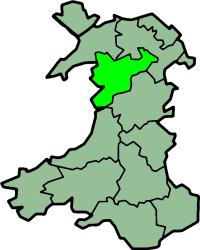Gruffydd ap Llywelyn was King of Wales from 1055 to 1063. He had previously been King of Gwynedd and Powys in 1039. He was the son of King Llywelyn ap Seisyll and Angharad daughter of Maredudd ab Owain, and the great-great-grandson of Hywel Dda.

Gruffudd ap Cynan, sometimes written as Gruffydd ap Cynan, was King of Gwynedd from 1081 until his death in 1137. In the course of a long and eventful life, he became a key figure in Welsh resistance to Norman rule, and was remembered as King of all Wales. As a descendant of Rhodri Mawr, Gruffudd ap Cynan was a senior member of the princely House of Aberffraw.

Meirionnydd is a coastal and mountainous region of Wales. It has been a kingdom, a cantref, a district and, as Merionethshire, a county.

The Kingdom of Gwynedd was a Roman Empire successor state that emerged in sub-Roman Britain in the 5th century during the Anglo-Saxon settlement of Britain.

Rhys ap Tewdwr was a king of Deheubarth in Wales and member of the Dinefwr dynasty, a branch descended from Rhodri the Great. He was born in the area which is now Carmarthenshire and died at the battle of Brecon in April 1093.
Trahaearn ap Caradog was a King of Gwynedd. Trahaearn was a son of Caradog ap Gwyn, ruler of Arwystli, a small state, on the south-western border between Gwynedd and Powys. He was born in 1044 in Arwystli, and died in 1081 in Mynydd Carn in Pembrokeshire, at the Battle of Mynydd Carn.
Brochwel son of Cyngen, better known as Brochwel Ysgrithrog, was a king of Powys in eastern Wales. The unusual epithet Ysgithrog has been translated as "of the canine teeth", "the fanged" or "of the tusk".
Caradog ap Gruffydd was a Prince of Gwent in south-east Wales in the time of Gruffydd ap Llywelyn and the Norman conquest, who reunified his family's inheritance of Morgannwg and made repeated attempts to reunite southern Wales by claiming the inheritance of the Kingdom of Deheubarth.

Eifionydd is an area in north-west Wales covering the south-eastern part of the Llŷn Peninsula from Porthmadog to just east of Pwllheli. The Afon Erch forms its western border. It now lies in Gwynedd.

Gwent was a medieval Welsh kingdom, lying between the Rivers Wye and Usk. It existed from the end of Roman rule in Britain in about the 5th century until the Norman invasion of Wales in the 11th century. Along with its neighbour Glywyssing, it seems to have had a great deal of cultural continuity with the earlier Silures, keeping their own courts and diocese separate from the rest of Wales until their conquest by Gruffydd ap Llywelyn. Although it recovered its independence after his death in 1063, Gwent was the first of the Welsh kingdoms to be overrun following the Norman conquest.
This article is about the particular significance of the century 1101–1200 to Wales and its people.
This article is about the particular significance of the century 1001–1100 to Wales and its people.
Nest ferch Cadell was the daughter of Cadell ap Brochfael, an 8th-century King of Powys, the wife of Merfyn Frych, King of Gwynedd.
The House of Aberffraw was a cadet branch of the Kingdom of Gwynedd originating from the sons of Rhodri the Great in the 9th century. Establishing the Royal court of the Aberffraw Commote would begin a new location from which to rule Wales. The cadet branch achieved the recognised title of Prince of Wales, and were sometimes named King of Aberffraw.
The House of Mathrafal began as a cadet branch of the House of Dinefwr, taking their name from Mathrafal Castle, their principal seat and effective capital. Although their fortunes rose and fell over the generations, they are primarily remembered as kings of Powys in central Wales.

Anwyl of Tywyn are a Welsh family who claim a patrilinear descent from Owain Gwynedd, King of Gwynedd from 1137 to 1170 and a scion of the royal House of Aberffraw. The family motto is: Eryr eryrod Eryri, which translates as "The Eagle of the Eagles of Snowdonia. The family lives in Gwynedd and speak Welsh.
Cadwallon ap Gruffydd was the eldest son of Gruffudd ap Cynan, king of Gwynedd.
This page is based on this
Wikipedia article Text is available under the
CC BY-SA 4.0 license; additional terms may apply.
Images, videos and audio are available under their respective licenses.






